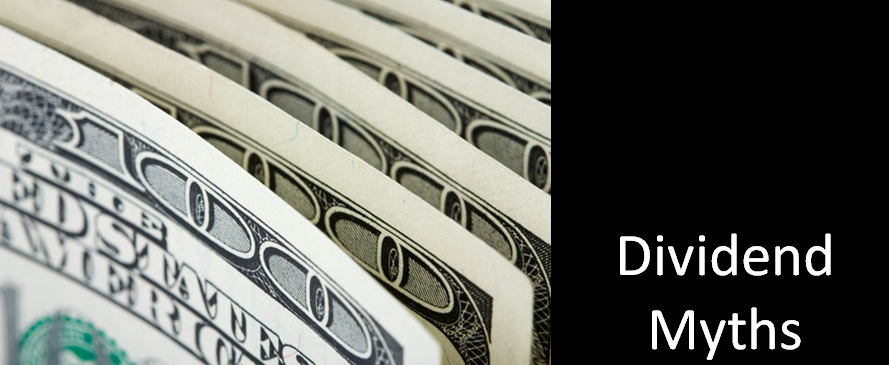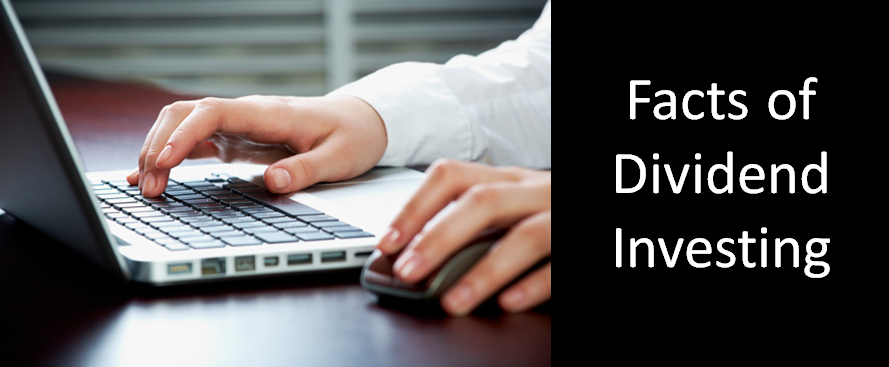Dividend investing can be a great investment strategy for investors, but there are several things investors should be aware of before investing in dividend stocks. Below are several myths, mistakes and facts about dividend investing.

On the surface, the concept of “dividend investing” seems like a very straightforward idea. Invest in companies that make distributions, reinvest those dividends regularly, and slowly accumulate wealth over the long run. In reality, however, implementing a successful dividend income strategy for your portfolio is far from an easy task.
Investors need to know what factors to consider, which ones to avoid, and how to spot stocks that look great on the surface but are in the process of crumbling. Below, we take a look at some of the common misunderstandings about dividend investing, and offer up some truth behind the myths.
Utilities and Telecoms Are the Only Reliable Sources of Dividends
This misconception comes from the idea that only mature industries pay reliable dividends. In the past, many mature and stable dividend-paying companies were utilities and telecommunication companies. But in the 21st century, there are established companies of every size in practically every industry that are paying dividends.
Check out the High Yield Dividend Stocks page for more investing ideas.
High Yield Is Always a Good Thing
The statement above is simply not true. Dividend yield is calculated by taking the dividend per share and dividing it by the price per share. The lower the price per share, the higher the dividend yield will be. Thus, a sharply falling stock price is often the reason behind a high yield.
Investors should look at the underlying reason why a stock has a high yield before making any investment decision. The last thing you would want is for the dividend to get cut when you least expect it. For more information on high yield risks, click here.
MLPs Are Risky Dividend Sources Tied to Energy Prices
In recent years, many investors have flocked to Master Limited Partnerships, or MLPs, as sources of attractive dividend yields. But many have hesitated to utilize this asset class due to concerns that the impact of energy prices will result in extreme volatility in stock price.
MLPs generally generate cash flow by transporting and storing energy commodities such as petroleum and natural gas — they operate the pipelines that get fuels across North America. But these entities aren’t as vulnerable to swings in gas prices as many would suspect. Because they generate fee-based revenues, MLPs actually have access to very stable income that doesn’t fluctuate with spot prices. Essentially, these companies operate toll roads that collect fees regardless of how much the vehicle passing through costs.
The Dividend.com Stock Screener allows investors to search the universe of MLPs to identify those securities that meet their criteria. You can also check out our complete list of MLPs.
Dividend Investing Is Equivalent to Value Investing
This misconception comes from the fact that value investors try to find stocks that look cheap, valuation-wise, while dividend investors are looking for stocks trading at low prices in comparison to the dividends. Though these methods are similar, they are not the same. The difference is that one is concerned with capital gains while the other is interested primarily in dividend income.
Value investors are interested in finding stocks trading at a discount to the company’s intrinsic value. This takes into account future cash flows, risks, growth and other factors over a period of time. Value investors look for a low price-to-earnings ratio, price-to-growth and price-to-book, among other ratios. The goal is to implement a margin of safety to overcome any errors in these assumptions and capitalize on the capital gain afterward. This is where the saying “Buy Low and Sell High” originates. Many value investors will be attracted to stocks that have never paid a dividend, or that have little prospect of making a cash payout anytime soon.
Dividend investors, on the other hand, may consider a completely different range of factors. While they’re also drawn to stocks that are cheap compared to the intrinsic value, there’s an increased emphasis on identifying businesses with sustainable cash flows over the long haul. Yields and payout ratios are more of a concern, as are the odds of dividend increases in the future.
Dividend Stocks Are Always Safe Stocks
This is not always true, and recent history has given us many examples of dividend-paying companies falling on hard times. While many investors have made money with dividend-paying stocks, there are others that have lost money by paying attention just to the dividend yield and not to the health of the company. Just during the past few years there have been plenty of examples. For instance, take General Motors (GM ), Bank of America (BAC ), Citigroup (C ) and Barnes and Noble (BNS) were all dividend paying stocks that suffered collapses of one type or another in the past five years. And the list goes on. Though these companies offered stable dividends at one time or another, it didn’t mean that they were immune from industry and financial changes. Learn more about some of the biggest dividend disasters of all time. For more information check out The Dow 30: A Look Into the Last Five Recessions.

The great global hunt is on. No, not for some exotic animal in the wild. The hunt is on in the global financial markets for something that has become rare: a decent yield. Thanks to the ZIRP (zero interest rate policy) being followed by nearly all the major central banks, such as the Federal Reserve, it has become harder and harder for individual investors (and institutions too) to find any investment out there that pays a decent yield.
No wonder then, that investors are moving in a big way into stocks with high dividend yields. But dividend investing is not a simple matter. It is very easy to overlook some key items that investors may come to regret later. Below are five common mistakes investors need to avoid in their dividend investing strategy.
Don’t Try to Time the Market
The second most common mistake is trying to time the market. No one knows where the tops and bottoms of the stock market are, not even the professionals. The best method to invest for dividend income is to scale in a monthly way with a set amount of money to be invested. One way to do so is through the use of a company’s dividend reinvestment plan, or DRIP. Most of the large companies offer DRIPs, and the advantages are a low barrier to entry (often less than $100 to begin), small initial fees (sometimes), no ongoing fees and low maintenance for the investor.
Pay Attention to the Dividend Dates
Another very common mistake made by investors is not buying a stock in time in order to capture the upcoming dividend, or selling too soon and forfeiting the upcoming dividend. Many investors wrongly focus on a company’s dividend record date. The record date is actually inconsequential for investors — it is simply the day on which the company will look at its records. The real key date for investors is the ex-dividend date, which is the date the company’s stock begins tradingwithout the dividend. Investors will notice the stock price is adjusted downward to account for the upcoming dividend payout. The ex-date is almost always the second business day before the record date. So if you want to get a company’s next dividend, you must purchase the stock one day before the ex-dividend date (three days before the record date). Find out more about ex-dividend dates in Everything Investors Need To Know About Ex-Dividend Dates.
Look Out for the Taxman
Another item dividend income investors need to watch out for is being surprised by a higher tax bill than they were expecting. This can easily occur if investors don’t pay attention to the type of dividends they are receiving. Most regular dividends received from U.S. are called qualified dividends. These dividends receive the favorable capital gains 15% tax rate, while non-qualified dividends are taxed at the higher ordinary income tax rate. Learn more in A Brief History of Dividend Tax Rates.
The general rule is that dividends are qualified if they are paid by a U.S. corporation or a foreign firm in a country with tax agreements in place with the United States. Also, stockholders need to hold the stock for more than 60 days during the 121-day period starting the 60 days before the ex-dividend date.
There are, however, some very common investments that do not pay qualified dividends. These include payments made by certain types of ETFs, as well as foreign companies from countries that do not have tax agreements with the United States.
Below is a tax chart as of 2013 for capital gains.
| Ordinary Tax Rate | Qualified Dividends | Non-Qualified Dividends |
|---|---|---|
| 10% | 0% | 10% |
| 15% | 0% | 15% |
| 25% | 15% | 25% |
| 28% | 15% | 28% |
| 33% | 15% | 33% |
| 35% | 15% | 35% |
| 39.6% | 20% | 39.6% |
Better to Buy Individual Dividend Stocks
Besides non-qualified dividends, ETFs can also trip up dividend investors who are not paying attention to the type of stocks the ETF is invested into. An ETF’s investment portfolio may not be compatible with your risk profile. There are several types of dividend ETFs that follow very different strategies. Some dividend ETFs, such as the Vanguard Dividend Appreciaton ETF, focus on consistent dividend payers. Other dividend ETFs, such as the Global X SuperDividend ETF, focus on the highest yielding stocks. So make sure to read the particular ETF’s prospectus and dividend strategy before investing.
Or better yet, just stick to the top individual dividend names and avoid the occasional complications that come along with ETFs.

While dividends have been a common feature of equity investing for over a century, dividend-focused investing continues to build in popularity. Not only do studies indicate long-term outperformance for dividend-paying stocks, but large dividend-oriented portfolios can provide a significant source of income for investors, whether in retirement or not. Below are some facts every investor should know.
Dividends Aren’t Just a Bonus
For all of the talk about “how to find the next Apple (AAPL ) ” or locating the next 10-bagger, sometimes dividends seem like a mere throw-in to investment returns. After all, what good is a 2% or 3% dividend yield against 100% capital gains?
Well, the reality is that dividends contribute substantial long-term value. Looking at the average annual return of the S&P 500 over the last 80 years, dividends have accounted for more than 40% of equity returns, and that number does not account for the compounding value of re-invested dividends. Consider this point as well: prior to the Great Depression (and even for a while thereafter), dividends were considered the primary source of return for stocks; capital gains were just something that were welcomed if they happened to come along. To education yourself further, check out 40 Things Every Dividend Investor Should Know About Dividend Investing.
Technology is Now a Valid Dividend Investing Destination
Traditionally, technology has been a veritable no-man’s land for dividend investors. Fast-growing tech companies needed their cash for reinvestment and growth, or to fuel acquisitions. Less commonly reported, but still significant, was the role of insider/founder ownership — many tech company founders held large amounts of the company’s stock and had no need for the taxable income that dividends represented, so they preferred to see cash used to build the business or repurchase shares.
Stock Dividends Aren’t Dividends
Although it has become less common in the last 10 or 20 years, some companies used to pay what are called stock dividends. In addition to (or sometimes in place of) cash dividends, companies would issue fractional shares of stock for every share held. Although some investors may have been fooled into think this was some sort of benefit, what they really amounted to were small-scale stock splits, and they built no real value for shareholders.
Distributions Are Different Than Dividends
Just as a stock dividend isn’t really a dividend, not all “dividend-paying” stocks actually pay dividends. Partnerships, trusts, and Real Estate Investment Trusts (REITs) actually pay distributions. While distributions look and act like dividends in many respects (investors see cash arrive in their account every month, quarter, or half-year), these payouts are in fact quite different. Firstly, many of these companies get very favorable tax treatment, essentially paying no income tax — so long as they distribute a very large percentage of their earnings.
What’s more, certain types of partnerships are able to pass along or accelerate the recognition of certain costs. What this means is that a distribution may be composed of both cash earnings, but also what is called a “return of capital.” These payments can be subjected to significantly different tax treatments and investors must understand the tax ramifications before advising clients to take large positions in such equities.
DRIPs: Easy and Beneficial, but Not Free
Dividend reinvestment is a great way to build capital over long holding periods. If an investor does not need the cash dividend a company pays immediately, that investor can elect to reinvest the dividend in the stock, buying more shares with the money.
While reinvesting dividends into stocks has always been an option, formal dividend reinvestment plans (DRIPs) make it even easier. With a DRIP, investors can generally avoid commissions (which in many cases may be a substantial percentage of the reinvestment amount) and sometimes even buy fractional shares of stock. Many individual companies offer dividend reinvestment programs, but so do most brokers.
DRIPs are a very convenient way to build stock positions, but they are not completely free. If the dividend comes from a stock held in a taxable account, that dividend amount is still fully taxable just as any other dividend would be. Find out more in Everything Investors Need To Know About DRIPs.
Foreign Dividends Are Different
Although there are many high-quality foreign companies that pay dividends on their stock, international dividend investing presents a few challenges and twists. First, currency moves can significantly impact the year-to-year value of those dividends when they are converted to dollars. What’s more, many foreign companies have taxes withheld on the dividends they pay — taxes that may not be recoverable if the stock is held in a tax-sheltered retirement account. Last and not least, many foreign companies have a different philosophy towards dividends. While American companies like to maintain a steady (or rising) dividend payment, many foreign companies focus instead on paying out a consistent percentage of earnings as dividends, meaning that the actual dividend payment can fluctuate wildly from quarter to quarter. This fact alone makes some foreign stocks completely unattractive for investors looking for steady dividend income. For more, check out Foreign Dividends: Tax Rates, Largest Payers, ADRs and ETFs.
Preferred Dividends Are a Different Beast
Like distributions, preferred stock dividends are quite different than common stock dividends. Because preferred stocks are often viewed as alternatives to bonds, preferred stocks often respond more dramatically to changes in interest rates. What’s more, preferred stock can often be called, meaning completely bought back by the company with no choice on the part of the shareholder. This means a lucrative source of income can vanish at a moment’s notice. It’s also important to note that preferred stock dividends are taxed differently than common stock dividends. For a full list of the preferred shares we cover, click here.
The Bottom Line
While dividend investing can be a great way to obtain extra income, it is important to take the lessons mentioned above into consideration. Investors should ensure that their dividend investing strategy does not carry more risk than they are willing to take.





